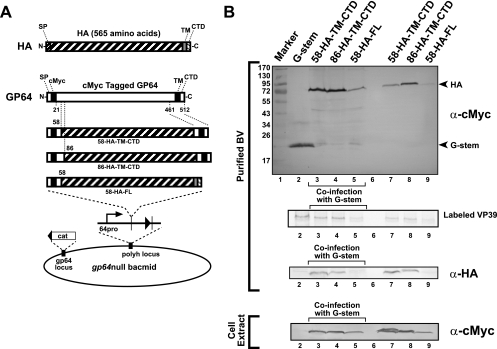FIG. 5.
Targeting of HA fusions to AcMNPV BV and enhanced budding by G-stem. (A) Strategy for generating HA-GP64 fusions and insertion of chimeric HA constructs into the polyhedrin locus of a gp64null AcMNPV bacmid. Chimeric HA-GP64 protein constructs were generated by fusing the HA ectodomain (residues 18 to 528) with the GP64 signal peptide, various portions from the N terminus of the GP64 ectodomain, and the GP64-stem region or the native HA TM domain and CTD. Constructs were expressed under the control of the gp64 promoter. Chimeric HA-GP64 proteins each contained an N-terminal c-Myc epitope tag, either 38 or 66 residues of the GP64 ectodomain (at the N terminus), and a 91-amino-acid GP64-stem sequence at the C terminus (constructs 58-HA-TM-CTD and 86-HA-TM-CTD). Construct 58-HA-FL contained a c-Myc epitope tag, 38 amino acids from the N terminus of the GP64 ectodomain, and the HA ectodomain, TM domain, and CTD (residues 18 to 565). (B) Western blot analysis of BV preparations. Purified BV preparations derived from cells infected with viruses expressing HA fusion proteins (lanes 7, 8, and 9) or coinfected with viruses expressing HA fusion proteins and a virus expressing the VSV G-stem construct (lanes 3, 4, and 5) were examined for the presence of envelope protein constructs by use of an anti-c-Myc antibody (purified BV, top panel) or an anti-HA antibody (purified BV, bottom panel). VP39 from purified [35S]methionine-labeled progeny BV (purified BV, middle panel) was detected by phosphorimager analysis and used to more directly compare levels of progeny BV production. A control infection with only the virus expressing the c-Myc-tagged G-stem construct is shown in lane 2. Cell extracts from the above preparations were also examined for protein expression by using anti-c-Myc antibody (bottom).

